How to fix this hole?
Need to patch this hole, it has wires over the studs. Hole too big to mud, but I don't think I can drywall patch it because of the wires in front. I would appreciate your help!
Comments (39)
millworkman
11 years agoHow about linking the picture properly I don't think anyone will sort thru all those pictures to see your question?
woodsy_1
11 years agoHere's your picture. It's not very clear and I'm no expert, but my thought is that you shouldn't patch over that wire. Wires need to go through the studs, not on the face of them. If at some point in the future a person were to put a nail in the wall at that point it will pierce the wire. The result is not fun and downright dangerous!
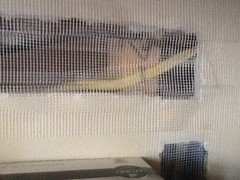
Related Professionals
Hillcrest Heights Handyman · Normal Kitchen & Bathroom Remodelers · Shaker Heights Kitchen & Bathroom Remodelers · Phillipsburg Kitchen & Bathroom Remodelers · Port Washington General Contractors · Bothell Painters · Bellevue Painters · Leesburg Painters · Champlin Painters · Cleveland Painters · East Norriton Painters · Ferndale Painters · Pensacola Painters · Spanish Fork Painters · Sunrise PaintersUser
11 years agoThat is very dangerous to have that wire like that!!!!!!!!!!!!
Find a way to move the wire behind the stud then patch the hole.
cas66ragtop
11 years agoIf you can't get the wire behind the stud, you can get a piece of heavy gauge steel and nail it on the stud, covering the wire - this will prevent nails from being driven into the wire.
stash-hdy
11 years agowhen was the wire run and by whom ? Can the wire be removed and installed to meet code?
sdello
11 years agoagreed with previous posts, the wire is not correct. My last house I found a similar situation where the previous owner had notched out a stud and run a wire directly below the wall board. This is quite improper. Technically, you cannot even bury a junction box in the wall to cut and splice it. IMO, you're options are to relocate the wire through the stud or cut it and splice it in an electrical box attached to the stud with a blind cover exposed on the finished wall. Depending on where the openieng is and the configuration of the circuit the wire is on, maybe you could cut the wire and add an outlet at that location, with the box next to the stud.
alan_s_thefirst
11 years agoWhat cas66ragtop said is absolutely incorrect, you can't just put metal over the wire. You won't have any depth to patch for one, and the wire will get crushed by the plate.
It's a terrible, non-code way to run wires. I can't imagine why/how.
If the stud is not going to be compromised structurally, you could notch the stud out enough for the wire to recess comfortably, THEN put a strike plate/nail guard - basically a piece of strong steel - over the wire, which will protect the wire from future nails/screws.
teresatree
Original Author11 years agoHi, sorry about the picture, I was on a tablet and I couldn't get it to cooperate. Thanks for adding the picture for me, I am just getting back online.Our home builder had this done, it was concealed behind our microwave shelf. They had the shelf installed too low, and when we raised it, this is what we found. (The company went out of business shortly after completing our home. They also forgot to stub in our plumbing for our basement bathroom.) We are planning to tile the area and the tiles are smaller than the hole, so I didn't think just tape and mud would be enough. So you guys are saying I need an electrician, then try to patch it? The best way to patch it then would be to.......?
This picture is how they first had our kitchen, forgetting the microwave shelf.

Then they added the shelf too low.
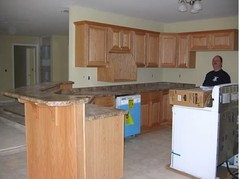
This is some of what we found when we raised the microwave shelf and above cabinet our self. There are three holes left in the wall. The picture might not show, but there is more than one wire over the stud.
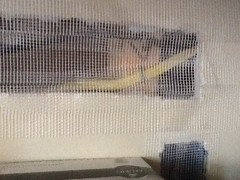
They did not have the tape, we put that on there, but I didn't think it would be enough and the wire placement bothered me.
teresatree
Original Author11 years agoJust saw Allen's post, thanks. I took me a while to complete my last post, and you must of posted while I was working on my post.
stash-hdy
11 years agoWhat I would do if this was my house would be to rerun the wires to code by cutting out sheetrock to get to the wires, patch the sheetrock and then install a tile backsplash. Is the house built on a slab or is there a basement?
cas66ragtop
11 years agoUh sorry Alan, but there was nothing wrong with what I suggested. And you basically repeated my suggestion anyway. You can't put a piece of metal over a wire because it will crush it? What do you think those staples are made of? They are "crushing" the wire way more than a metal plate would. The thickness of the metal plate directly over top what is already there is not going to affect your ability to patch the hole. If the the drywall patch buckles out a little bit directly over top this area, you either scrape away the back of the drywall that comes into contact with it, or you put nothing but drywall mud in that particular spot. It's not that hard.
If that were my place, I would pull out the staples, take a stanley knife and cut out a notch just deep enough to house the wire, place the wire in it, nail a metal plate over it and patch the hole. I forgot what they are called, (nail plate sounds good) but you can find them in the electrical section of Lowes or HD. You can even make your own nail plate out of a piece of heavy gauge scrap metal you may already have.
I didn't dare suggest notching the stud, because I knew someone would freak out and suggest the whole house might come tumbling down if you messed with the structural integrity of the stud. I also didn't want to suggest re-routing the wire behind the stud or through it. That means cutting the wire, which exposes the person to electric shock if they don't turn off the correct circuit. This also means in order to reconnect the wire and stay in code, you would have to have a junction box. And you might not have enough wire there to splice it back together anyway. It's better to leave the wire intact if you can.
woodsy_1
11 years agoI agree with cas66ragtop on one point. It is a very nice kitchen!
Am I reading correctly that this is new construction? If the builder did it the builder should fix it. I would be lying if I said I wasn't concerned about the way that wire was installed...and hidden. Makes me wonder what other violations are hiding behind that drywall. I would have a chat with the electrical inspector.
cas66ragtop
11 years agoWhat would you hope to accomplish by chatting w/the inspector?
Scenario 1: Mr. Contractor & Mr. Inspector says here is my proof of inspection - it passed - so what do you want me to do about it?
Scenario 2: Mr. Electrical inspector comes out, looks at this, sees this as a violation, and now demands all of the drywall be removed so he can redo his inspection. Mr. Contractor is going to be mad at Mr. Homeowner for ratting him out, and will find a way to charge Mr. Homeowner for additional repairs, or he will do substandard work just for spite. Mr. Inspector is either going to be mad at Mr. Contractor for sealing things up before the inpection was done, or he will be mad at Mr. Homeowner for claiming he didn't do a good enough of job of inspecting in the first place. So now Mr. Inspector is going to be really picky.
Who pays for all of this in the end? Mr. Homeowner. Not a very good answer.
drywall_diy_guy
11 years agoI think I would create a channel about 3/4" deep above or below this wire. Move the wire into the back of this channel. Then cover with a plate made for protecting wires that run through a stud (your hardware store has one). I assume this 2x2 or 2x4 behind is not structural in nature right? Remove the mesh tape and then put in plywood strips fastened through the drywall and attach the patch to the strips. See link below. The better way to fix this could end up being quite a job!
Here is a link that might be useful: Drywall Hole Repair
greg_2010
11 years agoIs the wire feeding the outlet below and to the right of the hole? If so, you may be able to open up that outlet (with electricity off obviously) and push the wire back out. Then drill a hole in the stud, feed the wire through it and back into the outlet box.
sdello
11 years agowoodsy1: FYI, from one of the OP posts: "The company went out of business shortly after completing our home. They also forgot to stub in our plumbing for our basement bathroom." I don't think there's uch recourse from the builder. The OP's house was "complete" so I'm not sure I'd want the builder back to fix anything.
"I agree with cas66ragtop on one point. It is a very nice kitchen!" X2.
cas66ragtop
"I didn't dare suggest notching the stud, because I knew someone would freak out and suggest the whole house might come tumbling down if you messed with the structural integrity of the stud. I also didn't want to suggest re-routing the wire behind the stud or through it. That means cutting the wire, which exposes the person to electric shock if they don't turn off the correct circuit. This also means in order to reconnect the wire and stay in code, you would have to have a junction box. And you might not have enough wire there to splice it back together anyway. It's better to leave the wire intact if you can."Um, if you're going to be cutting/notching using any tools adjacent to the wire then the power should be cutoff as a precaution anyway. If someone posts a concern about "structural integrity" from notching a single stud then maybe their "free advice" is worth just that.
To expand on drywall_diy_guy's idea, cut a 1/2 in. tall "notch" past the middle of the stud and put the wire in it. replace the outside of the notch with the a small piece of wood and the net result is the same as drilling a hole through the stud and running the wire through it (like it should have been done initially). The real difference is that the wire on either side of the stud is now loose and close to the center of the wall cavity as it should be. Drywall repair can be done like shown in the link.
I'd be quite interested in a professional electrican's opinion of the best way to fix this.
brickeyee
11 years agoNotch the face of the stud the thickness of the wire.
Two cuts with a hand saw and then use a chisel to pop out the section between.About 3/8 inch deep is all you need.
It is not enough to have any structural affect on a single stud.
Lay the wire in the notch and cover it with an approved nail protector.
they are hardened sheet metal 1.5 inches wide and about 2 inches tall.
You will probbaly have to buy a whole box of them (50 or 100) but they are not very expensive.The good ones have four tabs bent down (each corner) to form points you drive into the stud while straddling straddling the cable.
Instal the drywall patch.
Anyone that drives a cable staple in enough to pinch the cable tightly is a hack.
If you cannot get them just snug purchase the staples with the plastic plates that pad the cable.
cas66ragtop
11 years ago"I'd be quite interested in a professional electrican's opinion of the best way to fix this."
Well, I worked as a commercial electrician when I was much younger. I helped in the construction of 2 very large hospitals in the Wash DC metro area. That was 20 yrs ago, and they never burned down, so I guess the quality of my work was pretty good. My 10:14 comment is no different than drywall guys 13:28 comment.
sdello
11 years agoFWIW, I'm still not crazy about a "pinned" wire held close to the back of the drywall, but apparently it's acceptable.
teresatree: Go through the five (pictures) steps on the link and you'll see what everyone is talking about.
cas66ragtop: The chances are slim that the place wouldn't burn down if the wire was just covered up, but that doesn't mean it's quality work. As stated above, I discovered a similar condition in my old house when I removed wallpaper in the kitchen. The hot wire was in a shallow notch on top of a stud covered by only the wallpaper. I'll bet it was like that for 10-15 years before I came along. It didn't burn down either.
Here is a link that might be useful: covering a wire in a wall
cas66ragtop
11 years agoWow - I just re-read sdello's 14:02 post about notching the stud. Cuttining PAST the center and then using the piece you cut out as a plug for the front of the stud???? You have now totally destroyed the integrity of this stud. Cutting a small notch on the front of the stud and then covering the wire w/a nail plate is plenty sufficient, and the stud still maintains it's strength.
sdello
11 years ago1) for non-load bearing partition walls the stud essentially acts as a spacer creating a cavity for there only as a spacer reating a cavity for utilities and a form for the wall treatments on both sides. 2) Even for a load bearing wall, cutting one stud is not going to make or break the integrity of the wall.
If it does, you've got bigger problems than a wire crossing the face of it to worry about.
alan_s_thefirst
11 years agoThe box stores like Home Depot do sell nail plates singly, of course they're a lot more expensive that way.
A small notch just deep enough for the wire is enough, as Brickeyee said. If there's a little slack in the wire you can push it back enough to keep it back from the drywall if you wish.
I don't know how those hacks actually ran the wire in the first place, did they notch the drywall? Frightening that a home builder - I'm assuming it wasn't a handyman- can do/oversee such substandard work.
If those staples are the kind with the two nails, they're actually pretty gentle on the wire and will not crush it. The stud absolutely needs a notch for the nail guard.
The other issue otherwise is I'm sure the big lump of drywall mud will never stay in place, it'll be very thin over that wire/plate if it isn't notched.
teresatree
Original Author11 years agoTo answer some questions, yes, the house has an unfinished daylight basement. We had our home build by a builder company about 8 years ago. They went out of business and did not fix any of the problems after closing. (That warranty they kept telling us about was no good.) I think you can see in the earlier pictures, they planned the wall with just a few outlet boxes. I am assuming they had the electrical inspection before they dry-walled. It was after they dry-walled and put in the cabinets that we noticed they forgot about our appliance shelf. They then had to take out the cabinet and put in a shelf and add an outlet for the microwave plug. All of these weird holes and wires were hidden behind the back of the microwave shelf. I don't even know if they called an electrician back out, or if the cabinet man did this. We didn't find it till we moved the shelf up to a normal height. I tried taking more pictures, close up, but I don't think they show well with the tape over the holes. (we put the tape on)
Looks like we have all kind of wires back there.

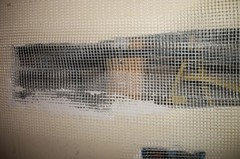


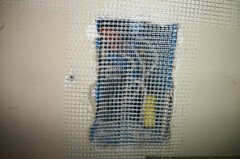
My hubby and I will have to read back over all your wonderful helpful notes above, to try to understand what to do. I think I understand the notching out and metal plate over, I'll read again to see if everyone though it would be OK that way.greg_2010
11 years agoWhy don't you remove the tape and take more pictures? You are going to have to remove it to make any repairs anyways.
And (as calm1 said) you can't cover up junction boxes! All splices need to be in accessible junction boxes.
teresatree
Original Author11 years agoWhat? The tape was put on by my husband to start fixing the wall so we could tile. Are you saying, because what they did, we can't tile over this area? :(
sdello
11 years agoAre the wires that go over the studs for the microwave? I'm wondering if they had everything wired correctlty (as shown in your very first picture) and they didn't accomodate the microwave shelf. Then some hack came in and installed the shelf. He added wires for the microwave by cutting a slot in the wall board and running the wires on top of the studs and then just covered the everything with the microwave shelf, including two existing future outlet recepticles.
Assuming that the wires shown are the only ones outboard of the studs one repair solution is to install plugs into the two exisitng junction boxes and add back the original plug layout, then notch and cover the wires at the studs as discussed. It is against code, good practice, and is generally a really bad idea to bury the junction boxes in the wall, especially without any cover as your tape job implies.
Personally, I'd be inclined to confirm that this is the only location where the wiring was done this way and make sure the rest of the house is ok.
Hope that helps.
greg_2010
11 years agoThe junction box with the wire nuts (the yellow and orange things) could be converted back to an outlet.
Does the other junction box contain a coaxial cable that has been extended to a new location? Is that the black cable that is passing through the upper hole to it's new location to the left of the holes?
If that's the case, then you could pull out that new coaxial cable section, remove the junction box that it terminates in to the left of the damage and patch that hole. Then use the old (currently taped up) junction box as the termination point.But I'm just guessing based on what I can make out from those pictures.
greg_2010
11 years agoLikewise, if the yellow cable is an extension from the old outlet location to a new spot, you may be able to remove the new spot's junction box.

alan_s_thefirst
11 years agoIf you don't want to use those junction boxes as outlets or whatever (or cable outlets) you can put blank plates over them. You CANNOT UNDER ANY CIRCUMSTANCES 'fill them' as you're proposing.
The cable tv outlet might be an exception, where I live they're less adamant about low voltage, but anywhere there's a connection, you want access in case you need to modify it or there's a problem.
You can certainly tile it but don't cover them over. You'll actually want "box extensions" for each outlet so that it remains flush with the tile.
If permitted by code, you can make your own box extension by using a hacksaw and cutting a 'slice' from another box as a spacer so it ends up flush with the tiles.
Here is a link that might be useful: Box extension
calm1
11 years agoThe best thing for you folks to do is get an electrician in there ASAP. They will explain your options & a licensed electrician will repair the nightmare you have there.
BTW based on this thread and others I have come to the conclusion that cas66ragtop is obviously educated beyond their intelligence.
Edbus_driver
11 years agoteresatree, the situation at your house done by others in time past is not at all correct. Your efforts and plans as presented here are making a mess worse. I have no confidence that you can personally get it right. But hey, neither can I do appendectomies.
brickeyee
11 years agoYou cannot conceal junction boxes behind drywall.
You cannot embed NM cable in drywall mud without a suitable nailing plate to protect the cable.
Changing the wiring NOW and then repairing the drywall correctly will be far easier than all the non-code things you have proposed.
You cannot put a junction box at the location the cable goes over the stud unless there is a LOT of slack in that cable.
You need any inches of wire length inside the box to meet the code.
The wire must extend inches past the front of the box from EACH cable.Replacing the whole cable from box-to-box with a new piece that goes through a bored hole in the stud is not that hard now.
As long as the hole edges are at least 1.25 inches from ether stud face you do not even need a nailing plate.
The plates are for drywall nail/screw protection, not longer screws.
Use a 18 inch long 1/2 inch diameter auger bit right in the middle of the stud for the hole (3.5 inch stud - 0.5 inch hole. divided by 2 leaves you with 1.5 inches to the stud faces. No plate required.
greg_2010
11 years agoI don't think you have to bore any new holes, use any nail plates, install any new junction boxes, hope that there is enough slack, or anything like that. Before everyone jumps all over me, let me explain.
The installation was most likely done properly by an electrician initially. Then the microwave shelf was requested. At which point, some hack came in and cut the drywall and extended the outlets that would be covered to new locations running wire in ridiculous ways.
Now that the microwave shelf has been moved to a more appropriate location, the hack's shoddy work is no longer needed. So the only thing you need to do is to put it back to the way it was before the hack came into the picture.
That's what I was trying to show in the images I posted above.
sdello
11 years agogreg: That's where I was going also.
If the OP comes back, she will hopefully relaize that her best approach is to have someone that knows what they are looking at, decipher the intent of the exposed wiring that was hidden behind the microwave shelf and make sure it's in some sort of reasonable configuration for reapir of the finish surface, Then she can either have someone reapir it or proceed with the repair herself.
All things considered it's really not a big job but the openings shown should not just be patched. In fact, covering wiring like this violates both the electrical codes and good practice.

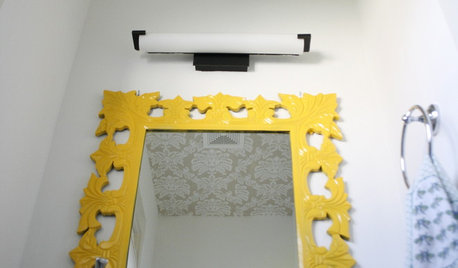

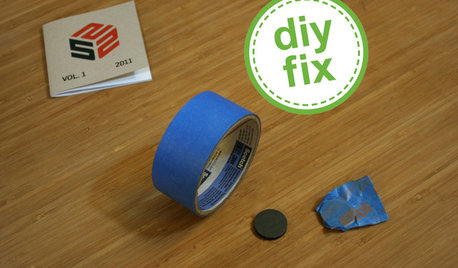
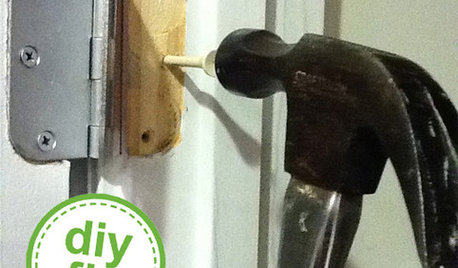


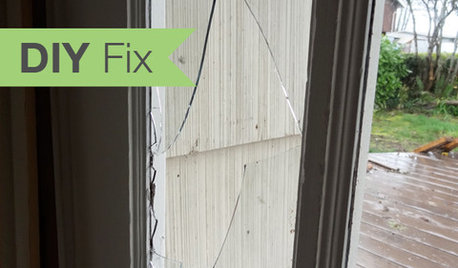









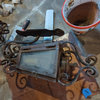
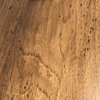

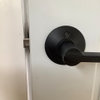
cas66ragtop